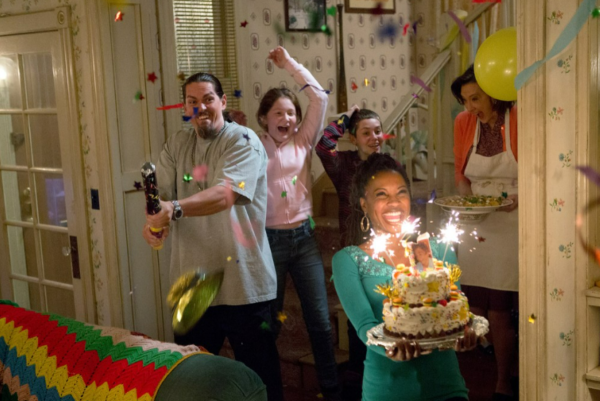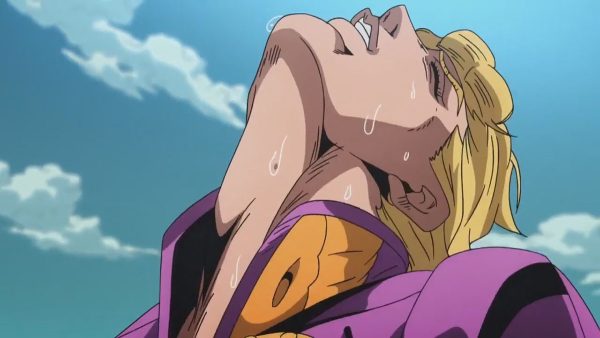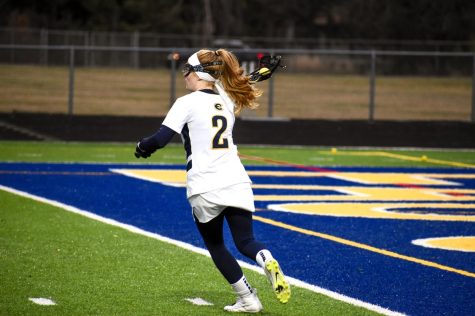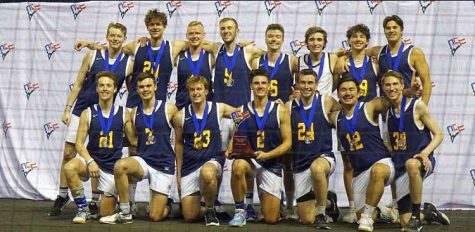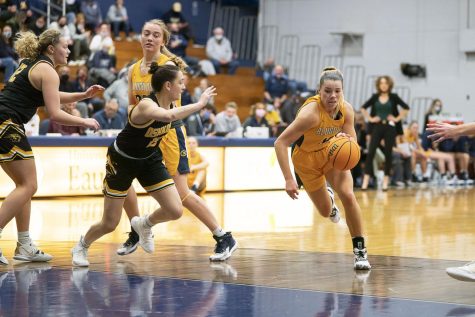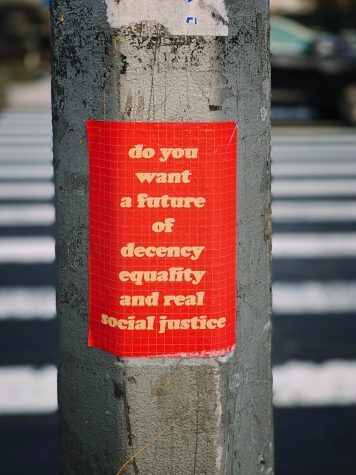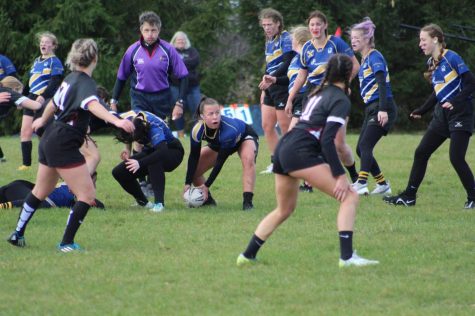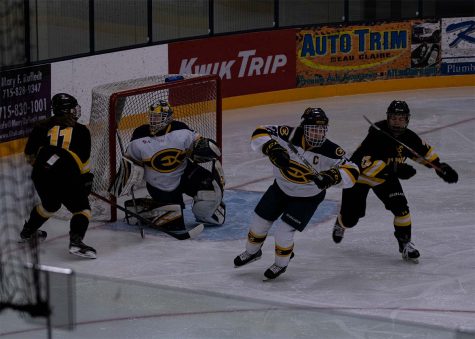Through the looking glass, and what Amy found there
Senior art student displays transparent truths about current events
When an observer peers through Amy Schleichert’s see-through art display in the Foster Art Gallery, they don’t find themselves in an alternate world, chasing a white rabbit in a waistcoat, singing with talking flowers or drinking tea with a mad man.
Instead, the viewer sees straight through the Wonderland in which government informs Americans they live in, and learns the true reality on the other side — literally.
Schleichert, a senior art student majoring in graphic design, said she didn’t feel educated enough about the current events that occurred during the fall semester. And after researching them, she said she found a large contrast between what the government and media was saying and what actually was happening beneath the surface.
“It’s obviously a disconnect,” Schleichert said. “We hear one thing and there’s a totally different thing that’s going on. It makes me very emotional and angry at times because these are the people we’ve chosen to rule our country and to take leadership … and we’re being lied to.”
She said that is what inspired Schleichert to use her graphic design skills as a communication device to inform the public about what they aren’t hearing, and to expose government hypocrisy.
Schleichert worked for an entire semester to construct her series of four works that hang in the Foster Art Gallery’s Bachelor of Fine Arts senior exhibition, located in the Haas Fine Arts Center. The four themes come from recent topics of public interest: Scott Walker and Collective Bargaining, Planned Parenthood, health care and Barack Obama’s policies.
The entire piece is comprised of four 20” by 24” photos Schleichert obtained from public domain sites. The aspect that makes it her own is her addition of four equally sized messages, printed on plexi-glass to give it the ability of being transparent. The clear prints hang exactly in line with the photos behind it, so when a viewer looks at each one dead on, the two images combined form one complete scene.
Art Department Chair Christos Theo mentored Schleichert through the process and gave advice on the best way to make her message come through. He said layering two images was Schleichert’s idea, and the physical form of the piece is actually a metaphor for the message, producing another ironic message of its own.
“Here’s this veil — what’s being told to you is the first layer, and what’s really happening is (see-through), so basically, something that should be transparent, but isn’t necessarily transparent,” Theo said.
Theo advised Schleichert that remaining unbiased could send a more credible message to a larger audience, and when artists get too attached or try to involve their opinion too strongly, the art becomes less interesting.
“My role was to kind of play as much of a non-partial role as possible in dealing of elements of, ‘Who’s buttons could you push?’,” Theo said.
Theo has taught Schleichert in various classes since she was a junior. He said it’s rewarding to watch a student grow over the years and realize when it’s time to “cut the leash,” as he put it, and observe how the students use the knowledge he has taught on their own.
All graduating seniors are required to submit a piece of art into the senior exhibition, which is held at the end of each semester. The students are responsible for funding all their materials, which can cost hundreds of dollars.
“From my point of view, this is our last show as students, so why not just go all out?” Schleichert said. “For some of us, it might be the last opportunity that we’ll have to do that in this environment.”
Despite months of research, more than $500 in materials, printing and installation costs, Schleichert said the public response at the exhibition’s reception
made it worthwhile.
“People were getting animated and talking to other people about it and that was pretty cool to see,” Schleichert said.
Aside from faculty approaching and congratulating her, she said she could recognize on their faces from a far, when bystanders figured out the message.
“Graphic design is visual communication,” Theo said, “which a lot of times people don’t think about.”
Future
Schleichert said after she graduates this month, she plans to send out her resume and look for a job in graphic design.
Forbes reported that nearly half of college graduates are working jobs that don’t require a four-year degree, and only 42 percent of visual and performing art graduates find work in their field.
This doesn’t scare Schleichert.
“It’s all about how much you’re willing to work for it, and how much you want to actually follow through with what you do,” she said. “It’s not impossible.”
Schleichert’s mother, Laverne Schleichert, also has faith in her.
“Amy was born with a colored crayon in her hand,” she said, and added how Schleichert would beg for the Disney magic art studio after watching hours of infomercials. Laverne Schleichert has seen her daughter evolve from coloring books to computer design. She said she just wants her daughter to be happy wherever she ends up and proud of herself.
Schleichert’s college years are coming to end in just a few days, but her unknown future awaits her through the looking-glass.

